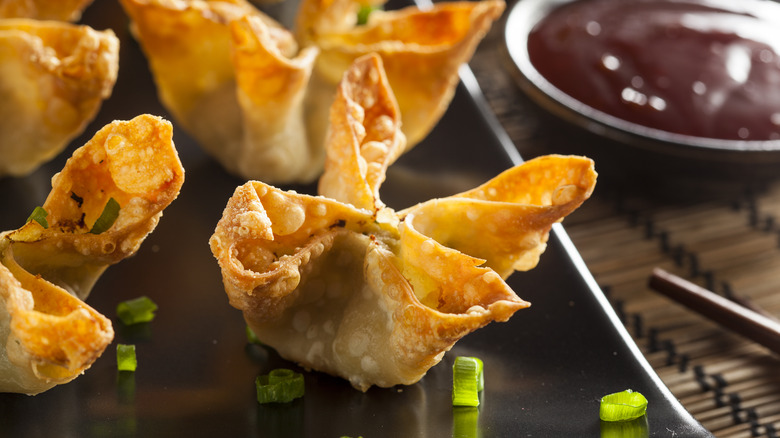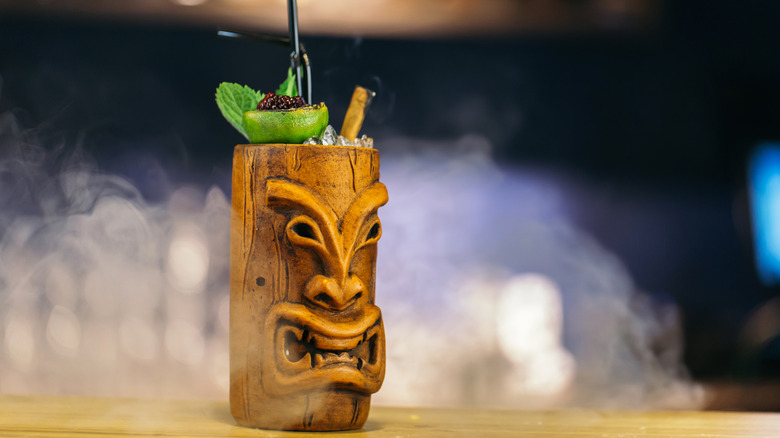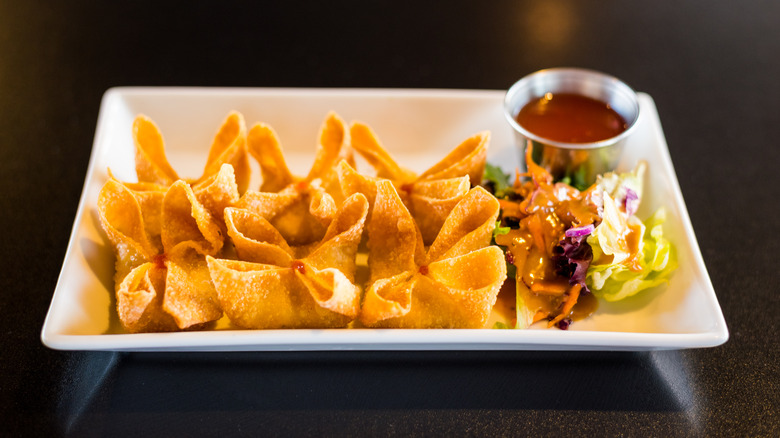Crab Rangoon: The Food Fusion Icon, Explained
Few foods represent the cultural melting pot model better than crab rangoon. It's a superficially simple item — a mixture of cream cheese and crab meat sealed in a wonton wrapper and fried to a golden crisp — but its origin story is a winding road through which a wide array of multinational cuisines cross paths. You can find it on the menu at almost every Chinese-American restaurant, which stirs more than a bit of controversy. Crab rangoon has been decried by some as the epitome of inauthentic dining.
Its only tie to China is the wonton wrapper. Cream cheese was invented in New York, the imitation crab many restaurants use was developed in Japan, and the dish's name refers to the Burmese city of Yangon, which was internationally known as Rangoon until 1989. To top it all off, a study found that over 90% of Chinese adults are lactose intolerant, so it's hard to imagine any of them would relish this dairy-heavy dish.
But calling crab rangoon inauthentic isn't entirely fair. The notion of "authentic" in the culinary world is flawed to begin with, given the fact that food around the world is constantly evolving as new ingredients and techniques are invented and exchanged among cultures. Chinese-American food, born of immigrants' adaptability, should be considered independent from Chinese food, a point argued by Kelly Kwok in an essay for The New York Times. As a signature piece of this unique cuisine, crab rangoon's story is worthy of note.
Crab Rangoon was born of mid-century Tiki culture
Today, crab rangoon is associated with Chinese-American restaurants, but those weren't the first to serve it. It originally appeared on the menu at a tiki bar. Considered novelties by many today, tiki bars were a big deal in mid-1900s America. Their aesthetic was based around a mish-mash of Polynesian iconography, East Asian food, and Caribbean drinks, often presented in racist ways that primitivized and sexualized native Pacific Islanders. The first tiki bar in the United States, Don the Beachcomber, was opened in Hollywood in 1933 by Donn Beach (born Ernest Gannt), a Prohibition-era bootlegger who had extensively traveled throughout the Caribbean and South Pacific.
Don the Beachcomber inspired another restaurateur, Victor Bergeron, to convert his Oakland, California bar, Hinky Dinks, into a tiki bar, renaming it Trader Vic's. Bergeron is most famous for inventing the Mai Tai cocktail but is also credited with inventing crab rangoon. Trader Vic's menu was mostly Chinese-American food, largely informed by one of the establishment's barbacks, Chinese-American Joe Young. Foo young, fried rice, and wontons were among the first foods they offered. Bergeron's granddaughter Eve told Atlas Obscura that he loved to experiment with ingredients from the kitchen, and sometime in the 1940s, he made a mixture of crab and cream cheese (a very popular ingredient of that era) and stuffed it in a wonton wrapper. He reportedly chose the name rangoon because the Burmese city's name sounded "exotic" but was easy for Americans to pronounce.
How crab rangoon became a Chinese restaurant staple
At the same time that tiki culture was on the rise, Chinese restaurants were gaining mainstream popularity. The history of Chinese-American food begins long before, though. The California Gold Rush of 1849 brought a wave of Cantonese immigrants to the U.S., sparking xenophobia that led to the Chinese Exclusion Act of 1882, banning Chinese laborers from entering the country. In 1915, a court decided that restaurateurs were eligible for special merchant visas, making restaurant ownership one of the few ways Chinese immigrants could establish U.S. residency. Chinese restaurants began popping up nationwide, but their owners couldn't access the same ingredients as they could back home. Their kitchens became experimental spaces where new dishes were born, and old ones were reimagined.
In the mid-1900s, a cyclical relationship developed wherein tiki bars would adapt popular Chinese-American recipes into new dishes, which would become popular in their own right and be taken back and further adapted by Chinese cooks. Wontons inspired crab rangoon, which then bounced back to Chinese menus. Most Chinese-American restaurants use menus printed by a handful of companies in New York and California. This has resulted in a certain uniformity among Chinese-American restaurants, which share most of the same dishes. Once crab rangoon became popular at one establishment, thousands of others around the country had it added to their menus as well. It's now available at most Chinese-American eateries, and, of course, you can always make crab rangoon at home.


